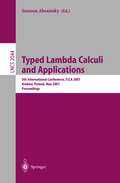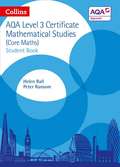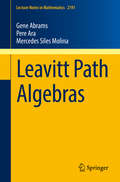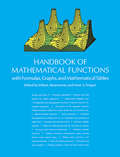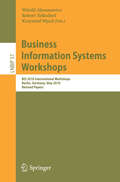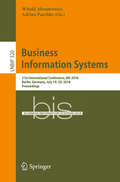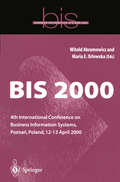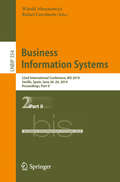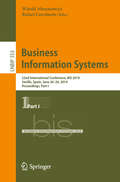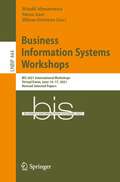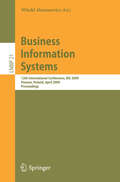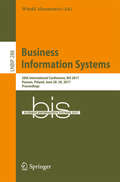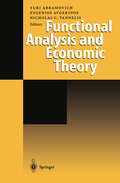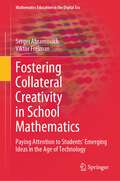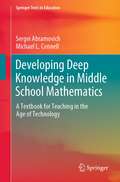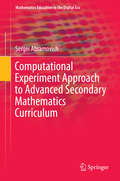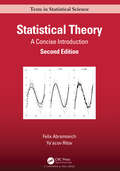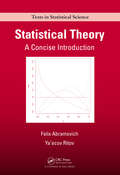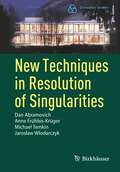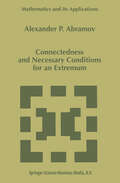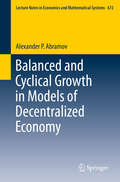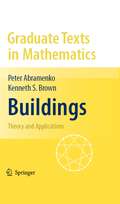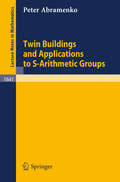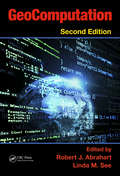- Table View
- List View
Typed Lambda Calculi and Applications: 5th International Conference, TLCA 2001 Krakow, Poland, May 2-5, 2001 Proceedings (Lecture Notes in Computer Science #2044)
by Samson AbramskyThis book constitutes the refereed proceedings of the 5th International Conference on Typed Lambda Calculi and Applications, TLCA 2001, held in Krakow, Poland in May 2001. The 28 revised full papers presented were carefully reviewed and selected from 55 submissions. The volume reports research results on all current aspects of typed lambda calculi. Among the topics addressed are type systems, subtypes, coalgebraic methods, pi-calculus, recursive games, various types of lambda calculi, reductions, substitutions, normalization, linear logic, cut-elimination, prelogical relations, and mu calculus.
AQA Core Maths — AQA Level 3 Mathematical Studies Student Book (Aqa Core Maths Ser.)
by Jack Abramsky Huw Kyffin Helen Ball Kevin Davis Peter RansomExam Board: AQA Level & Subject: Level 3 Maths First teaching: September 2014 First exams: June 2016 AQA approved Engage and motivate your AQA Core Maths students with a rich variety of real-life data and contexts. • Help students to access the AQA Level 3 Mathematical Studies specification with explanations, examples and plenty of practice. • Help all students reach their potential with differentiated exercises and project work. • Capture students’ interest with a real-world chapter opener and Mathematics in the real world sections throughout • Prepare for exams with exam-style questions in chapter 14 • Get students talking with Discussions that include open-ended questions • Focus on technical vocabulary and unfamiliar terms with key term definitions on the page • Draw together learning from each chapter with a Case Study • Provide extended tasks with the Project work sections at the end of each chapter • Assess your learning before moving on with the Check your progress feature • Check your understanding with answers at the back
Leavitt Path Algebras (Lecture Notes in Mathematics #2191)
by Gene Abrams Pere Ara Mercedes Siles MolinaThis book offers a comprehensive introduction by three of the leading experts in the field, collecting fundamental results and open problems in a single volume.Since Leavitt path algebras were first defined in 2005, interest in these algebras has grown substantially, with ring theorists as well as researchers working in graph C*-algebras, group theory and symbolic dynamics attracted to the topic. Providing a historical perspective on the subject, the authors review existing arguments, establish new results, and outline the major themes and ring-theoretic concepts, such as the ideal structure, Z-grading and the close link between Leavitt path algebras and graph C*-algebras. The book also presents key lines of current research, including the Algebraic Kirchberg Phillips Question, various additional classification questions, and connections to noncommutative algebraic geometry.Leavitt Path Algebras will appeal to graduate students and researchers working in the field and related areas, such as C*-algebras and symbolic dynamics. With its descriptive writing style, this book is highly accessible.
Handbook of Mathematical Functions: with Formulas, Graphs, and Mathematical Tables
by Milton Abramowitz Irene A. StegunDespite the increasing use of computers, the basic need for mathematical tables continues. Tables serve a vital role in preliminary surveys of problems before programming for machine operation, and they are indispensable to thousands of engineers and scientists without access to machines. Because of automatic computers, however, and because of recent scientific advances, a greater variety of functions and a higher accuracy of tabulation than have been available until now are required.In 1954, a conference on mathematical tables, sponsored by M.I.T. and the National Science Foundation, met to discuss a modernization and extension of Jahnke and Emde's classical tables of functions. This volume, published 10 years later by the U.S. Department of Commerce, is the result. Designed to include a maximum of information and to meet the needs of scientists in all fields, it is a monumental piece of work, a comprehensive and self-contained summary of the mathematical functions that arise in physical and engineering problems.The book contains 29 sets of tables, some to as high as 20 places: mathematical constants; physical constants and conversion factors (6 tables); exponential integral and related functions (7); error function and Fresnel integrals (12); Bessel functions of integer (12) and fractional (13) order; integrals of Bessel functions (2); Struve and related functions (2); confluent hypergeometric functions (2); Coulomb wave functions (2); hypergeometric functions; Jacobian elliptic and theta functions (2); elliptic integrals {9); Weierstrass elliptic and related functions; parabolic cylinder functions {3); Mathieu functions (2); spheroidal wave functions (5); orthogonal polynomials (13); combinatorial analysis (9); numerical interpolation, differentiation and integration (11); probability functions (ll); scales of notation (6); miscellaneous functions (9); Laplace transforms (2); and others.Each of these sections is prefaced by a list of related formulas and graphs: differential equations, series expansions, special functions, and other basic relations. These constitute an unusually valuable reference work in themselves. The prefatory material also includes an explanation of the numerical methods involved in using the tables that follow and a bibliography. Numerical examples illustrate the use of each table and explain the computation of function values which lie outside its range, while the editors' introduction describes higher-order interpolation procedures. Well over100 figures illustrate the text.In all, this is one of the most ambitious and useful books of its type ever published, an essential aid in all scientific and engineering research, problem solving, experimentation and field work. This low-cost edition contains every page of the original government publication.
Business Information Systems Workshops: BIS 2010 International Workshop, Berlin, Germany, May 3-5, 2010, Revised Papers (Lecture Notes in Business Information Processing #57)
by Witold Abramowicz Robert Tolksdorf Krzysztof WecelBusiness information systems is a rapidly developing domain. There are many topicsthatdeserveattentionbuthavenotyetfoundaplaceincanonicalresearch. Workshops give researchers the possibility to share preliminary ideas, ?rst - perimental results, or to discuss research hypotheses. Discussions held during presentations strengthen the paper and prepare it for publication. From our - perience, workshops are a perfect instrument with which to create a community aroundvery speci?c researchtopics, thus o?ering the opportunity to promote it. Topics that do not ?nd critical feedback at the main International Conference on Business Information Systems (BIS) may experience fruitful discussion when confronted with a well-focused audience. Over the last few decades, business informationsystems have been one of the most important factors of the transition toward a knowledge-based economy. At the same time they have been subject to continuous rapid development and innovation driven both by industry and by academia. For the last 12 years these innovations were carefully observed but also shaped by researchers attending BIS yearly.
Business Information Systems: 21st International Conference, BIS 2018, Berlin, Germany, July 18-20, 2018, Proceedings (Lecture Notes in Business Information Processing #320)
by Witold Abramowicz Adrian PaschkeThis book constitutes the proceedings of the 21st International Conference on Business Information Systems, BIS 2018, held in Berlin, Germany, in July 2018. The BIS conference follows popular research trends, both in the academic and the business domain. Thus the theme of BIS 2018 was "Digital Transformation - An Imperative in Today's Business Markets". The 30 papers presented in this volume were carefully reviewed and selected from 96 submissions. They were organized in topical sections named: big and smart data and artificial intelligence; business and enterprise modeling; ICT project management; process management; smart infrastructures; social media and Web-based business information systems; applications, evaluations, and experiences.
BIS 2000: 4th International Conference on Business Information Systems, Pozna?, Poland, 12–13 April 2000
by Witold Abramowicz Maria E. OrlowskaThis volume contains papers presented during the science trace at the 4th International Conference of Business Information Systems, BIS 2000, held in Poznan, Poland, 12-13 April 2000, which discussed the development, implementation, applications and improvement of computer systems for business processes.The papers deal with practical, industry experiences and validated prototype implementations, and cover areas such as integration of information systems, electronic transactions and banking, virtual organisations, network technologies, business information systems modelling and analysis.
Business Information Systems: 22nd International Conference, BIS 2019, Seville, Spain, June 26–28, 2019, Proceedings, Part II (Lecture Notes in Business Information Processing #354)
by Witold Abramowicz Rafael CorchueloThe two-volume set LNBIP 353 and 354 constitutes the proceedings of the 22nd International Conference on Business Information Systems, BIS 2019, held in Seville, Spain, in June 2019. The theme of the BIS 2019 was "Data Science for Business Information Systems", inspiring researchers to share theoretical and practical knowledge of the different aspects related to Data Science in enterprises. The 67 papers presented in these proceedings were carefully reviewed and selected from 223 submissions. The contributions were organized in topical sections as follows: Part I: Big Data and Data Science; Artificial Intelligence; ICT Project Management; and Smart Infrastructure. Part II: Social Media and Web-based Systems; and Applications, Evaluations and Experiences.
Business Information Systems: 22nd International Conference, BIS 2019, Seville, Spain, June 26–28, 2019, Proceedings, Part I (Lecture Notes in Business Information Processing #353)
by Witold Abramowicz Rafael CorchueloThe two-volume set LNBIP 353 and 354 constitutes the proceedings of the 22nd International Conference on Business Information Systems, BIS 2019, held in Seville, Spain, in June 2019. The theme of the BIS 2019 was "Data Science for Business Information Systems", inspiring researchers to share theoretical and practical knowledge of the different aspects related to Data Science in enterprises. The 67 papers presented in these proceedings were carefully reviewed and selected from 223 submissions. The contributions were organized in topical sections as follows: Part I: Big Data and Data Science; Artificial Intelligence; ICT Project Management; and Smart Infrastructure. Part II: Social Media and Web-based Systems; and Applications, Evaluations and Experiences.
Business Information Systems Workshops: BIS 2021 International Workshops, Virtual Event, June 14–17, 2021, Revised Selected Papers (Lecture Notes in Business Information Processing #444)
by Witold Abramowicz Sören Auer Milena StróżynaThis book constitutes revised papers from the eight workshops which were held during June 2021 at the 24th International Conference on Business Information Systems, BIS 2021. The conference was planned to take place in Hannover, Germany, and changed to a fully online event due to the COVID-19 pandemic. There was a total of 67 submissions to all workshops of which 31papers were accepted for publication. The workshops included in this volume are: AKTB 2021: 12th Workshop on Applications of Knowledge-Based Technologies in Business BisEd 2021: BIS Education: Trends and Challenges DigBD 2021: 1st Workshop on Digitization in the Flux of Big Data Scenarios DigEx 2021: 3rd International Workshop on transforming the Digital Customer Experience iCRM 2021: 6th International Workshop on Integrated Social CRM QOD 2021: 4th Workshop on Quality of Open Data BITA 2021: 12th Workshop on Business and IT Alignment BSCT 2021: 4th Workshop on Blockchain and Smart Contract Technologies
Business Information Systems: 12th International Conference, BIS 2009, Poznan, Poland, April 27-29, 2009, Proceedings (Lecture Notes in Business Information Processing #21)
by Witold AbramowiczBusiness Information Systems: 20th International Conference, BIS 2017, Poznan, Poland, June 28–30, 2017, Proceedings (Lecture Notes in Business Information Processing #288)
by Witold AbramowiczThis book constitutes the refereed proceedings of the 20th International Conference on Business Information Systems, BIS 2017, held in Poznań, Poland, in June 2017. Big Data Analytics helps to understand and enhance enterprises by linking many fields of information technology and business. This year’s conference theme was: Big Data Analytics for Business and Public Administration. The 24 full papers presented in this volume were carefully reviewed and selected from 72 submissions. They were organized in topical sections named: big and smart data; business and enterprise modeling; ICT project management; process management; smart infrastructure; and applications.
Functional Analysis and Economic Theory
by Yuri Abramovich Evgenios Avgerinos Nicholas C. YannelisIn July of 1996, the conference Nonlinear Analysis and its Applications in Engineering and Economics took place on the Greek island of Samos, the birthplace of Pythagoras. During this conference, a special session was held on th the occasion of the 50 birthday of the well known mathematician and math ematical economist Professor Charalambos Aliprantis, who, by his numerous friends, is usually called Roko. The story behind this nickname is not quite clear yet; it will be investigated further and will be made public prior to his th 60 birthday. (At this moment we have already found out that it has nothing to do with the famous movie Rocco and his Brothers even though Roko does have two brothers. ) Roko was born on the Greek island of Cephalonia on May 12,1946, and his elementary and secondary school education took place there. At 18 he entered the Mathematics Department at the University of Athens. Upon graduation from the University of Athens he proceeded with his graduate studies at Cal tech, where in 1973 he completed his Ph. D. degree in Mathematics under the supervision of Professor W. A. J. Luxemburg. His research career can be divided into two periods. The first one, till 1981, was devoted entirely to pure mathematics. The other one, after 1981, has been subdivided between pure mathematics and mathematical economics. The main objects of Roko's work in pure mathematics are spaces with order structure (Riesz spaces) and operators acting on them.
Fostering Collateral Creativity in School Mathematics: Paying Attention to Students’ Emerging Ideas in the Age of Technology (Mathematics Education in the Digital Era #23)
by Sergei Abramovich Viktor FreimanThis book explores the topic of using technology, both physical and digital, to motivate creative mathematical thinking among students who are not considered ‘mathematically advanced.’ The book reflects the authors’ experience of teaching mathematics to Canadian and American teacher candidates and supervising several field-based activities by the candidates. It consists of eight chapters and an Appendix which includes details of constructing computational learning environments.Specifically, the book demonstrates how the appropriate use of technology in the teaching of mathematics can create conditions for the emergence of what may be called ‘collateral creativity,’ a notion similar to Dewey’s notion of collateral learning. Just as collateral learning does not result from the immediate goal of the traditional curriculum, collateral creativity does not result from the immediate goal of traditional problem solving. Rather, mathematical creativity emerges as a collateral outcome of thinking afforded by the use of technology. Furthermore, collateral creativity is an educative outcome of one’s learning experience with pedagogy that motivates students to ask questions about computer-generated or tactile-derived information and assists them in finding answers to their own or the teacher’s questions. This book intends to provide guidance to teachers for fostering collateral creativity in their classrooms.
Developing Deep Knowledge in Middle School Mathematics: A Textbook for Teaching in the Age of Technology (Springer Texts in Education)
by Sergei Abramovich Michael L. ConnellThis textbook is for prospective teachers of middle school mathematics. It reflects on the authors’ experience in offering various mathematics education courses to prospective teachers in the US and Canada. In particular, the content can support one or more of 24-semester-hour courses recommended by the Conference Board of the Mathematical Sciences (2012) for the mathematical preparation of middle school teachers. The textbook integrates grade-appropriate content on all major topics in the middle school mathematics curriculum with international recommendations for teaching the content, making it relevant for a global readership. The textbook emphasizes the inherent connections between mathematics and real life, since many mathematical concepts and procedures stem from common sense, something that schoolchildren intuitively possess. This focus on teaching formal mathematics with reference to real life and common sense is essential to its pedagogical approach. In addition, the textbook stresses the importance of being able to use technology as an exploratory tool, and being familiar with its strengths and weaknesses. In keeping with this emphasis on the use of technology, both physical (manipulatives) and digital (commonly available educational software), it also explores e.g. the use of computer graphing software for digital fabrication. In closing, the textbook addresses the issue of creativity as a crucial aspect of education in the digital age in general, and in mathematics education in particular.
Computational Experiment Approach to Advanced Secondary Mathematics Curriculum (Mathematics Education in the Digital Era #3)
by Sergei AbramovichThis book promotes the experimental mathematics approach in the context of secondary mathematics curriculum by exploring mathematical models depending on parameters that were typically considered advanced in the pre-digital education era. This approach, by drawing on the power of computers to perform numerical computations and graphical constructions, stimulates formal learning of mathematics through making sense of a computational experiment. It allows one (in the spirit of Freudenthal) to bridge serious mathematical content and contemporary teaching practice. In other words, the notion of teaching experiment can be extended to include a true mathematical experiment. When used appropriately, the approach creates conditions for collateral learning (in the spirit of Dewey) to occur including the development of skills important for engineering applications of mathematics. In the context of a mathematics teacher education program, the book addresses a call for the preparation of teachers capable of utilizing modern technology tools for the modeling-based teaching of mathematics with a focus on methods conducive to the improvement of the whole STEM education at the secondary level. By the same token, using the book’s pedagogy and its mathematical content in a pre-college classroom can assist teachers in introducing students to the ideas that develop the foundation of engineering profession.
Statistical Theory: A Concise Introduction (Chapman & Hall/CRC Texts in Statistical Science)
by Felix Abramovich Ya'acov RitovDesigned for a one-semester advanced undergraduate or graduate statistical theory course, Statistical Theory: A Concise Introduction, Second Edition clearly explains the underlying ideas, mathematics, and principles of major statistical concepts, including parameter estimation, confidence intervals, hypothesis testing, asymptotic analysis, Bayesian inference, linear models, nonparametric statistics, and elements of decision theory. It introduces these topics on a clear intuitive level using illustrative examples in addition to the formal definitions, theorems, and proofs. Based on the authors’ lecture notes, the book is self-contained, which maintains a proper balance between the clarity and rigor of exposition. In a few cases, the authors present a "sketched" version of a proof, explaining its main ideas rather than giving detailed technical mathematical and probabilistic arguments. Features: Second edition has been updated with a new chapter on Nonparametric Estimation; a significant update to the chapter on Statistical Decision Theory; and other updates throughout No requirement for heavy calculus, and simple questions throughout the text help students check their understanding of the material Each chapter also includes a set of exercises that range in level of difficulty Self-contained, and can be used by the students to understand the theory Chapters and sections marked by asterisks contain more advanced topics and may be omitted Special chapters on linear models and nonparametric statistics show how the main theoretical concepts can be applied to well-known and frequently used statistical tools The primary audience for the book is students who want to understand the theoretical basis of mathematical statistics—either advanced undergraduate or graduate students. It will also be an excellent reference for researchers from statistics and other quantitative disciplines.
Statistical Theory: A Concise Introduction (Chapman & Hall/CRC Texts in Statistical Science)
by Felix Abramovich Ya'acov RitovDesigned for a one-semester advanced undergraduate or graduate statistical theory course, Statistical Theory: A Concise Introduction, Second Edition clearly explains the underlying ideas, mathematics, and principles of major statistical concepts, including parameter estimation, confidence intervals, hypothesis testing, asymptotic analysis, Bayesian inference, linear models, nonparametric statistics, and elements of decision theory. It introduces these topics on a clear intuitive level using illustrative examples in addition to the formal definitions, theorems, and proofs. Based on the authors’ lecture notes, the book is self-contained, which maintains a proper balance between the clarity and rigor of exposition. In a few cases, the authors present a "sketched" version of a proof, explaining its main ideas rather than giving detailed technical mathematical and probabilistic arguments. Features: Second edition has been updated with a new chapter on Nonparametric Estimation; a significant update to the chapter on Statistical Decision Theory; and other updates throughout No requirement for heavy calculus, and simple questions throughout the text help students check their understanding of the material Each chapter also includes a set of exercises that range in level of difficulty Self-contained, and can be used by the students to understand the theory Chapters and sections marked by asterisks contain more advanced topics and may be omitted Special chapters on linear models and nonparametric statistics show how the main theoretical concepts can be applied to well-known and frequently used statistical tools The primary audience for the book is students who want to understand the theoretical basis of mathematical statistics—either advanced undergraduate or graduate students. It will also be an excellent reference for researchers from statistics and other quantitative disciplines.
Statistical Theory: A Concise Introduction (Chapman And Hall/crc Texts In Statistical Science Ser.)
by Felix AbramovichDesigned for a one-semester advanced undergraduate or graduate course, Statistical Theory: A Concise Introduction clearly explains the underlying ideas and principles of major statistical concepts, including parameter estimation, confidence intervals, hypothesis testing, asymptotic analysis, Bayesian inference, and elements of decision theory. It i
New Techniques in Resolution of Singularities (Oberwolfach Seminars #50)
by Dan Abramovich Anne Frühbis-Krüger Michael Temkin Jarosław WłodarczykResolution of singularities is notorious as a difficult topic within algebraic geometry. Recent work, aiming at resolution of families and semistable reduction, infused the subject with logarithmic geometry and algebraic stacks, two techniques essential for the current theory of moduli spaces. As a byproduct a short, a simple and efficient functorial resolution procedure in characteristic 0 using just algebraic stacks was produced. The goals of the book, the result of an Oberwolfach Seminar, are to introduce readers to explicit techniques of resolution of singularities with access to computer implementations, introduce readers to the theories of algebraic stacks and logarithmic structures, and to resolution in families and semistable reduction methods.
Connectedness and Necessary Conditions for an Extremum (Mathematics and Its Applications #431)
by Alexey AbramovThe present book is the outcome of efforts to introduce topological connectedness as one of the basic tools for the study of necessary conditions for an extremum. Apparently this monograph is the first book in the theory of maxima and minima where topological connectedness is used so widely for this purpose. Its application permits us to obtain new results in this sphere and to consider the classical results from a nonstandard point of view. Regarding the style of the present book it should be remarked that it is comparatively elementary. The author has made constant efforts to make the book as self-contained as possible. Certainly, familiarity with the basic facts of topology, functional analysis, and the theory of optimization is assumed. The book is written for applied mathematicians and graduate students interested in the theory of optimization and its applications. We present the synthesis of the well known Dybovitskii'-Milyutin ap proach for the study of necessary conditions for an extremum, based on functional analysis, and topological methods. This synthesis allows us to show that in some cases we have the following important result: if the Euler equation has no non trivial solution at a point of an extremum, then some inclusion is valid for the functionals belonging to the dual space. This general result is obtained for an optimization problem considered in a lin ear topological space. We also show an application of our result to some problems of nonlinear programming and optimal control.
Balanced and Cyclical Growth in Models of Decentralized Economy (Lecture Notes in Economics and Mathematical Systems #672)
by Alexander P. AbramovThis book is devoted to the study of dynamical models of decentralized economic systems. The models considered are based on the Leontief simple dynamic model with various mechanisms for decentralized planning and management. Branches of the economic system are treated as fully independent economic agents that plan their work according to their own purposes. It is shown that the lack of coordination between economic agents leads to a limit cycle for some economic indicators. Conversely, the exchange of information between the economic agents enables a move toward balanced growth. These results are generalized for the model with dynamics of the productive assets and for the model with the final consumption. The analysis also considers a problem of endogenous technological progress in a decentralized economy. The appendix includes a short review of non-negative matrices. The book offers a valuable resource for mathematical economists and graduate students specializing in mathematical economics.
Buildings: Theory and Applications (Graduate Texts in Mathematics #248)
by Peter Abramenko Kenneth S. BrownThis book treats Jacques Tit's beautiful theory of buildings, making that theory accessible to readers with minimal background. It covers all three approaches to buildings, so that the reader can choose to concentrate on one particular approach. Beginners can use parts of the new book as a friendly introduction to buildings, but the book also contains valuable material for the active researcher. This book is suitable as a textbook, with many exercises, and it may also be used for self-study.
Twin Buildings and Applications to S-Arithmetic Groups (Lecture Notes in Mathematics #1641)
by Peter AbramenkoThis book is addressed to mathematicians and advanced students interested in buildings, groups and their interplay. Its first part introduces - presupposing good knowledge of ordinary buildings - the theory of twin buildings, discusses its group-theoretic background (twin BN-pairs), investigates geometric aspects of twin buildings and applies them to determine finiteness properties of certain S-arithmetic groups. This application depends on topological properties of some subcomplexes of spherical buildings. The background of this problem, some examples and the complete solution for all "sufficiently large" classical buildings are covered in detail in the second part of the book.
GeoComputation
by Robert J. Abrahart Linda M. SeeA revision of Openshaw and Abrahart's seminal work, GeoComputation, Second Edition retains influences of its originators while also providing updated, state-of-the-art information on changes in the computational environment. In keeping with the field's development, this new edition takes a broader view and provides comprehensive coverage across the
